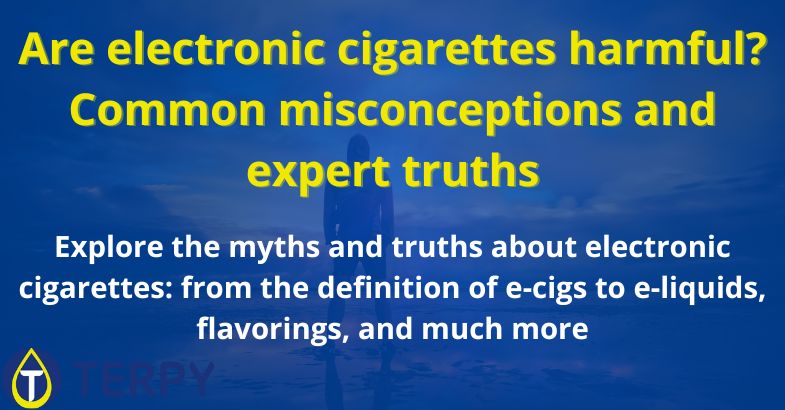Published on: 18/07/2025
Explore the myths and truths about electronic cigarettes: from the definition of e-cigs to e-liquids, flavorings, and much more
The debate over e-cigs has never been so heated: some see them as a health breakthrough compared to traditional cigarettes, while others fear the possible risks of inhaling vapors containing nicotine and flavorings.
In this article, we will analyze in detail how e-cigs and e-liquids work, debunk the main misconceptions, and shed light on the positions expressed by internationally recognized researchers. The goal of our in-depth review is to provide an accurate and evidence-based overview to answer the question: are electronic cigarettes really harmful?
What is an electronic cigarette?
The electronic cigarette, commonly called an e-cig, is an electronic device designed to turn a liquid—composed of propylene glycol, vegetable glycerin, flavorings, and sometimes nicotine—into vapor. Unlike burned tobacco, which produces thousands of harmful compounds, the e-cig uses a battery to heat a coil, vaporizing the liquid and thus generating an aerosol to inhale.
Introduced to the market in the early 2000s, e-cigs have evolved from the first cig-a-like models to more sophisticated pod mods, and finally to disposable electronic cigarettes—known as puff bars. These single-use devices, ready to use and without replaceable components, have expanded the user base by making vaping accessible even to those who do not want to dealrefills or coil replacements.
Read also : Disposable e-cigarette: where to buy?
Why are they less harmful than traditional cigarettes?
Numerous studies and international health organizations recognize that e-cigarettes are less harmful than traditional cigarettes. The main reason lies in the absence of combustion: since tobacco is not burned, the formation of most irritant and carcinogenic substances is avoided.
Reduction of toxins: while traditional smoke contains over 7,000 compounds, including at least 70 known carcinogens, e-cigarette aerosol contains significantly lower amounts of toxic substances. Laboratory tests have shown that the concentration of tar and carbon monoxide is virtually zero.
Nicotine dosage control: liquids for electronic cigarettes come in varying concentrations, from 0 mg/ml to the legal maximum. This allows for gradual reduction of nicotine and personalization of the vaping experience, by choosing liquids with different flavor intensities.
Impact on the respiratory system: although inhaling any foreign substance can cause irritation, comparative studies indicate that those who completely switch to e-cigarettes have better lung function and reduced respiratory symptoms compared to cigarette smokers.
Less passive smoke: the aerosol released contains particles that persist less in the air and, although not odorless, is less harmful to those around the vaper.


Common misconceptions about electronic cigarettes
Over the years, several myths have arisen around e-cigarettes, sometimes amplified by misleading articles. Here are the most common:
“E-cigarettes cause explosions and fires”: although incidents involving defective batteries have been reported, these are isolated cases related to improper charging practices or uncertified devices. Using quality products and original chargers drastically reduces the risk.
“Liquid flavors are toxic”: some studies have found irritant substances like diacetyl in unregulated liquids. However, manufacturers complying with European regulations (TPD) use food-grade flavorings subject to strict controls.
“You don’t know what’s in the liquid”: legislation requires full ingredient labeling and notification to the Ministry of Health. Purchasing from authorized retailers guarantees transparency.
“E-cigarettes create new addictions”: nicotine remains an addictive substance, but the gradual reduction mechanism promotes quitting more than traditional smoking. Additionally, nicotine-free options have increased in recent years.
“Vaping causes ‘popcorn lung’”: this disease, known as bronchiolitis obliterans, was previously linked to diacetyl found in poor-quality flavorings; however, liquids that comply with current regulations contain no diacetyl or only negligible amounts, effectively eliminating the risk.
“E-cigarette vapor is harmful secondhand smoke”: the aerosol from e-cigarettes disperses quickly in the air and contains only minimal traces of harmful compounds. Numerous studies show that the risk to bystanders is much lower compared to traditional cigarette secondhand smoke.
“E-cigarettes damage the lungs like cigarettes”: while inhaling aerosol can cause irritation, research indicates that lung damage associated with vaping is much less severe and sometimes reversible compared to damage from tobacco smoking.
Read also : Which e-cigarette to choose? A complete guide to navigate the world of vaping
Scientists and Electronic Cigarettes: Authoritative Opinions
The scientific debate on e-cigarettes and health includes studies and statements from internationally recognized institutions and researchers:


- Public Health England (PHE): In its 2015 report, PHE stated that e-cigarettes are at least 95% less harmful than traditional cigarettes and recommended their use as a harm reduction tool.
- Prof. Peter Hajek (Queen Mary University of London): A pioneer in vaping research, he highlighted that e-cigarettes represent an effective tool for quitting smoking and do not carry risks comparable to those of combustible tobacco.
- Prof. Konstantinos Farsalinos (Onassis Cardiac Surgery Center, Greece): His studies analyzed the chemical composition of aerosols, confirming that their toxicity levels are far lower than those found in traditional smoke.
- World Health Organization (WHO): While not endorsing electronic cigarettes as an official smoking cessation therapy, the WHO recognized their harm reduction potential compared to traditional cigarettes and called for regulations to limit youth access.
- Royal College of Physicians (RCP): In the 2016 document “Nicotine without Smoke,” the RCP emphasized that e-cigarettes could play a key role in reducing the harmful effects of smoking, suggesting their inclusion in tobacco control strategies.
National Academies of Sciences, Engineering, and Medicine (NASEM): In its 2018 report, NASEM observed that e-cigarette aerosol generally contains much lower concentrations of toxic substances than cigarette smoke, while recommending further research on long-term effects.
Conclusion
In light of scientific research and authoritative opinions, it appears that e-cigarettes, although not risk-free, represent a significantly less harmful choice compared to traditional cigarettes. The various e-cigarette liquids and flavorings available on the market allow users to customize their experience and, for those using nicotine, to gradually reduce the dosage.
Challenging common myths and relying on expert studies and evaluations is essential to navigate this constantly evolving context with awareness, making the most of the benefits of e-cigarettes while not overlooking their potential limitations.





